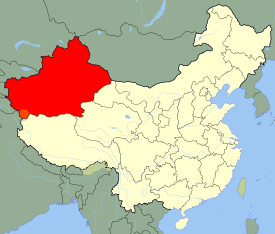Turpan
| Turpan تۇرپان 吐鲁番市 |
|
|---|---|
| — County-level City — | |
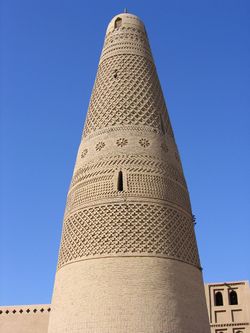 |
|
 Turpan
|
|
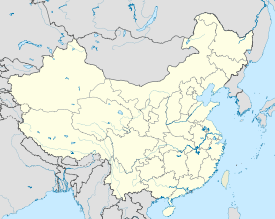 Turpan
|
|
| Coordinates: | |
| Country | China |
| Province | Xinjiang |
| Prefecture | Turpan Prefecture |
| Population (2003) | |
| - Total | 254,900 |
Turpan (Uyghur: تۇرپان, ULY: Turpan; Turkish: Turfan; simplified Chinese: wikt:吐鲁番; traditional Chinese: 吐魯番; pinyin: Tǔlǔfān), also known as Turfan or Tulufan, is an oasis county-level city in Turpan Prefecture, in Xinjiang Uyghur Autonomous Region of the People's Republic of China. Its population was 254,900 at the end of 2003.
Contents |
History

Turpan has long been the centre of a fertile oasis (with water provided by karez) and an important trade centre. It was historically located along the Silk Road's northern route, at which time it was adjacent to the kingdoms of Korla and Karashahr to the southwest and the town of Qarakhoja (Gaochang) to the southeast.
The peoples of the Kingdoms of Nearer and Further Jushi 車師 (the Turpan Oasis and the region to the north of the mountains near modern Jimasa), were closely related. It was originally one kingdom called Gushi 故師 (Wade-Giles: Ku-shih) which the Chinese conquered in 107 BCE.[1] It was subdivided into two kingdoms by the Chinese in 60 BCE. During the Han era the city changed hands several times between the Xiongnu and the Han, interspersed with short periods of independence.[2]
After the fall of the Han Dynasty, the region was virtually independent but tributary to various dynasties. Until the 5th century CE, the capital of this kingdom was Jiaohe (modern Yarghul - 16 km west of Turpan).[3]
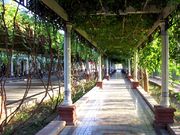
From 487 to 541 AD Turpan was an independent Kingdom ruled by a Turkish tribe known to the Chinese as the Tiele. The Rouran Khaganate defeated the Tiele and subjugated Turpan, but soon afterwards the Rouran were destroyed by the Göktürks.
In the mid 7th century the Tarim Basin was reoccupied by the Chinese, now under the Tang Dynasty. During the 7th, 8th, and early 9th centuries the whole region was fought over by the Tang, the Tibetan Empire, and the Turks. Under Tang rule, it was a center of major commercial activity between Chinese and Sogdian merchants. Mazdaism was the religion practiced by the Sogdians, and there were many inns in Turpan, some provided sex workers with an opportunity to service the Silk Road merchants since the official histories report that there were markets in women at both Kucha and Khotan.[4] The Sogdian-language contract buried at the Astana graveyard demonstrates that at least one Chinese man bought a Sogdian girl in 639 AD. One of the archeologists who excavated the Astana site, Wu Zhen, contends that, although many households along the Silk Road bought individual slaves, as we can see in the earlier documents from Niya, the Turpan documents point to a massive escalation in the volume of the slave trade.[5]

The few documented pairings of Chinese male owners with Sogdian girls raise the question how often Sogdian and Chinese families intermarried. The historical record is largely silent on this topic, but Rong Xinjiang has found a total of twenty-one recorded marriages in the seventh century in which one partner was Sogdian, and in eighteen cases, the spouse is also Sogdian. The only exceptions are very high-ranking Sogdian officials who married Chinese wives.[6] He concludes that most Sogdian men took Sogdian wives, and we may surmise that the pairings between Chinese men and Sogdian women were usually between a male master and a female slave. Several commercial interactions were recorded In 673 a company commander (duizheng ) bought a camel for fourteen bolts of silk from Kang Wupoyan ,[7] a non-resident merchant from Samarkand (Kangzhou ).[8] In 731 a Sogdian merchant sold an eleven-year-old girl to a resident of Chang’an, Tang Rong , for forty bolts of silk.[9] Five men served as guarantors, vouching that she was not a free person who had been enslaved (The Tang Code banned the enslavement of commoners.)[10]
The Uyghurs established a Kingdom in Turpan (known as the Uyghuria Idikut state or Kara-Khoja Uyghur Idikut Kingdom) that lasted from 856 to 1389 AD, surviving as a vassal of the Mongol Empire. This Kingdom, led by Idikuts, or Saint Spiritual Rulers, was established after the fall of the Uyghur Empire to the Kyrgyz Turks. Last Idikut left Turpan area in 1284 for Kumul, then Gansu to seek protection of Yuan Dynasty, but local uyghur Buddhist rulers still held power until Invasion of Moghul Hizir Khoja in 1389. The conversion of the local Buddhist population to Islam was completed nevertheless only in the second half of the 15th century.
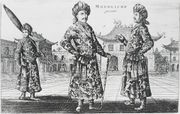
The Moghul ruler of Turpan Yunus Khan, also known as Ḥājjī `Ali, (ruled 1462-1478) unified Moghulistan (roughly corresponding to today's Eastern Xinjiang) under his authority in 1472. Around that time, a conflict with the Ming China started over the issues of so-called tribute trade: Turpanians loved sending so-called "tribute missions" to China, which allowed them to receive valuable gifts from the Ming emperors and to do plenty of trading on the sides; the Chinese, however, felt that receiving and entertaining these missions was just too expensive. Yunus Khan was irritated by the restrictions on the frequency and size of Turpanian missions (no more than one mission in 5 years, with no more than 10 members) imposed by the Ming government in 1465, and by the Ming's refusal to bestow sufficiently luxurious gifts on his envoys (1469). According, in 1473 he went to war against China, and even succeeded in capturing Hami and holding it for a while.[11]
Francis Younghusband visited Turpan in 1887 on his overland journey from Beijing to India. He said it consisted of two walled towns, a Chinese one with a population of no more than 5,000 and, about a mile (1.6 km) to the west, a Turk town of "probably" 12,000 to 15,000 inhabitants. The town (presumably the "Turk town") had four gateways, one for each of the cardinal directions, of solid brickwork and massive wooden doors plated with iron and covered by a semicircular bastion. The well-kept walls were of mud and about 35 ft (10.7 m) tall and 20 to 30 feet (6 to 9 m) thick, with loopholes at the top. There was a level space about 15 yards (14 m) wide outside the main walls surrounded by a musketry wall about 8 ft (2.4 m) high, with a ditch around it some 12 ft (3.7 m) deep and 20 ft (6 m) wide). There were drumtowers over the gateways, small square towers at the corners and two small square bastions between the corners and the gateways, "two to each front." Wheat, cotton, poppies, melons and grapes were grown in the surrounding fields.[12]
Turpan grapes impressed other travelers to the region as well. The 19th-century Russian explorer Grigory Grumm-Grzhimaylo, thought the local raisins may be "the best in the world", and noted the buildings of a "perfectly peculiar design" used for drying them.[13]
Geography and climate
| Turpan | ||||||||||||||||||||||||||||||||||||||||||||||||||||||||||||
|---|---|---|---|---|---|---|---|---|---|---|---|---|---|---|---|---|---|---|---|---|---|---|---|---|---|---|---|---|---|---|---|---|---|---|---|---|---|---|---|---|---|---|---|---|---|---|---|---|---|---|---|---|---|---|---|---|---|---|---|---|
| Climate chart () | ||||||||||||||||||||||||||||||||||||||||||||||||||||||||||||
|
||||||||||||||||||||||||||||||||||||||||||||||||||||||||||||
|
||||||||||||||||||||||||||||||||||||||||||||||||||||||||||||
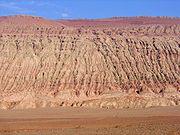
Turpan is located about 150 km (93 mi) southeast of Ürümqi, Xinjiang's capital, in a mountain basin, on the northern side of the Turpan Depression, at an elevation of 30 m (98 ft) above sea level.
Turpan has a harsh, cold desert climate (Koppen BWk), with long and very hot summers, winters of moderate cold and length, and springs and autumns that are short but warm. Annual precipitation is very low, amounting to only 15.7 mm (0.62 in). July is the hottest month, with average highs of 39.6 °C (103 °F) and lows of 25.0 °C (77 °F), while January is the coldest, with highs of −2.3 °C (28 °F) and lows of −12.1 °C (10 °F).
According to the CMA, records in the city have ranged from −24.4 °C (−12 °F) to 47.7 °C (118 °F).[14]
However, the very heat and dryness of the summer, when combined with the area's ancient system of irrigation, allows the countryside around Turpan to produce great quantities of high-quality fruit.
| Climate data for Turpan (1971-2000) | |||||||||||||
|---|---|---|---|---|---|---|---|---|---|---|---|---|---|
| Month | Jan | Feb | Mar | Apr | May | Jun | Jul | Aug | Sep | Oct | Nov | Dec | Year |
| Average high °C (°F) | −2.3 (27.9) |
6.0 (42.8) |
16.3 (61.3) |
26.5 (79.7) |
33.3 (91.9) |
37.9 (100.2) |
39.6 (103.3) |
38.0 (100.4) |
31.9 (89.4) |
21.8 (71.2) |
9.5 (49.1) |
−0.8 (30.6) |
21.5 (70.7) |
| Average low °C (°F) | −12.1 (10.2) |
−6.0 (21) |
3.2 (37.8) |
12.4 (54.3) |
18.7 (65.7) |
23.2 (73.8) |
25.0 (77) |
22.8 (73) |
16.3 (61.3) |
7.1 (44.8) |
−2.1 (28.2) |
−9.6 (14.7) |
8.2 (46.8) |
| Precipitation mm (inches) | 1.1 (0.043) |
0.5 (0.02) |
1.2 (0.047) |
0.5 (0.02) |
0.9 (0.035) |
2.9 (0.114) |
1.9 (0.075) |
1.8 (0.071) |
1.6 (0.063) |
1.7 (0.067) |
0.6 (0.024) |
1.0 (0.039) |
15.7 (0.618) |
| % Humidity | 60 | 45 | 31 | 26 | 28 | 31 | 33 | 37 | 42 | 51 | 54 | 61 | 41.6 |
| Avg. precipitation days (≥ 0.1 mm) | 1.5 | 0.3 | 0.3 | 0.6 | 0.9 | 2.3 | 2.0 | 1.9 | 1.2 | 0.7 | 0.3 | 1.1 | 13.1 |
| Sunshine hours | 159.7 | 188.6 | 239.5 | 256.8 | 299.6 | 301.2 | 311.7 | 305.9 | 278.8 | 250.6 | 184.7 | 135.1 | 2,912.2 |
| Source: China Meteorological Administration [14] | |||||||||||||
Demography
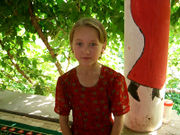
According to the 2000 census, the city of Turpan had a population of 251,652 (population density 15.99 inh./km²). The breakdown by nationality was as follows:
| Ethnicity | Inhabitants | Percentage |
|---|---|---|
| Uyghur | 177,106 | 70.38% |
| Han | 55,238 | 21.95% |
| Hui | 18,482 | 7.34% |
| Tujia | 182 | 0.07% |
| Manchu | 132 | 0.05% |
| Tu | 98 | 0.04% |
| Mongol | 77 | 0.03% |
| Tibetan | 70 | 0.03% |
| Kazakh | 56 | 0.02% |
| Miao | 45 | 0.02% |
| Russian | 33 | 0.01% |
| Zhuang | 31 | 0.01% |
| Dongxiang | 30 | 0.01% |
| Iranian | 72 | 0.03% |
Transport
- China National Highway 312
See also
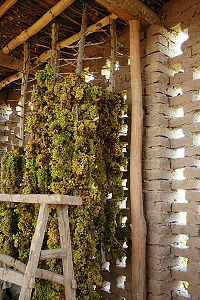
- Bezeklik Thousand Buddha Caves
- Gaochang
- Tarim mummies
- Jiaohe Ruins
- Flaming Mountains
- Dingling (with a special section about the Fufuluo)
- Turpan Museum
- Ayding Lake
- Chunche
Footnotes
- ↑ Hill (2009), p. 109.
- ↑ Hill (2009), p. 442.
- ↑ [1]
- ↑ Xin Tangshu 221a:6230. In addition, Susan Whitfield offers a fictionalized account of a Kuchean courtesan's experiences in the ninth century without providing any sources, although she has clearly drawn on the description of the prostitutes’ quarter in Chang’an in Beilizhi; Whitfield, 1999, pp. 138-154.
- ↑ Wu Zhen2000 (p. 154 is a Chinese-language rendering based on Yoshida's Japanese translation of the Sogdian contract of 639).
- ↑ Rong Xinjiang, 2001, pp. 132-135. Of the twenty-one epitaphs, twelve are from Quan Tangwen buyi (Supplement to the complete writings of the Tang), five from Tangdai muzhi huibian (Collected epitaphs of the Tang), three were excavated at Guyuan, Ningxia, and one is from another site.
- ↑ Yan is a common ending for Sogdian first names meaning ‘for the benefit of’ a certain deity. For other examples, see Cai Hongsheng, 1998, p. 40.
- ↑ Ikeda contract 29.
- ↑ Ikeda contract 31. Yoshida Yutaka and Arakawa Masaharu saw this document, which was clearly a copy of the original with space left for the places where the seals appeared.
- ↑ http://www.yale.edu/history/faculty/materials/hansen-silk-road-trade.pdf
- ↑ Godrich & Fang 1976
- ↑ Younghusband, Francis E. (1896). The Heart of a Continent, pp. 139-140. John Murray, London. Facsimile reprint: (2005) Elbiron Classics. ISBN 1-4212-6551-6 (pbk); ISBN 1-4212-6550-8 (hardcover).
- ↑ Grigory Grumm-Grzhimaylo (Г. Грум-Гржимайло), East Turkestan (Восточный Туркестан), in Brockhaus and Efron Encyclopedic Dictionary. (Russian) (The original quote: «Турфан же славится и своим изюмом, который можно считать лучшим в мире (высушивается в совершенно своеобразного типа сушильнях)», i.e. "Turfan is also famous for its raisins, which may be deemed the best in the world. They are dried in drying houses of a completely peculiar type".
- ↑ 14.0 14.1 14.2 "中国地面国际交换站气候标准值月值数据集(1971-2000年)" (in Simplified Chinese). China Meteorological Administration. http://cdc.cma.gov.cn/shuju/search1.jsp?dsid=SURF_CLI_CHN_MUL_MMON_19712000_CES&tpcat=SURF&type=table&pageid=3. Retrieved 2010-04-03.
References
- Godrich, L. Carrington; Fang, Chaoying, eds. (1976), "Ḥājjī `Ali", Dictionary of Ming Biography, 1368–1644. Volume I (A-L), Columbia University Press, pp. 479–481, ISBN 0-231-03801-1, http://books.google.com.au/books?id=067On0JgItAC&pg=PA479
- Hill, John E. (2009) Through the Jade Gate to Rome: A Study of the Silk Routes during the Later Han Dynasty, 1st to 2nd Centuries CE. BookSurge, Charleston, South Carolina. ISBN 978-1-4392-2134-1.
- Hill, John E. 2004. The Peoples of the West from the Weilue 魏略 by Yu Huan 魚豢: A Third Century Chinese Account Composed between 239 and 265 CE. Draft annotated English translation. [2]
- Hulsewé A. F. P. and Loewe, M. A. N. 1979. China in Central Asia: The Early Stage 125 BC – AD 23: an annotated translation of chapters 61 and 96 of the History of the Former Han Dynasty. E. J. Brill, Leiden.
- Puri, B. N. Buddhism in Central Asia, Motilal Banarsidass Publishers Private Limited, Delhi, 1987. (2000 reprint).
- Stein, Aurel M. 1912. Ruins of Desert Cathay: Personal narrative of explorations in Central Asia and westernmost China, 2 vols. Reprint: Delhi. Low Price Publications. 1990.
- Stein, Aurel M. 1921. Serindia: Detailed report of explorations in Central Asia and westernmost China, 5 vols. London & Oxford. Clarendon Press. Reprint: Delhi. Motilal Banarsidass. 1980.[3]
- Stein Aurel M. 1928. Innermost Asia: Detailed report of explorations in Central Asia, Kan-su and Eastern Iran, 5 vols. Clarendon Press. Reprint: New Delhi. Cosmo Publications. 1981.
- Yu, Taishan. 2004. A History of the Relationships between the Western and Eastern Han, Wei, Jin, Northern and Southern Dynasties and the Western Regions. Sino-Platonic Papers No. 131 March, 2004. Dept. of East Asian Languages and Civilizations, University of Pennsylvania.
External links
- Silk Road Seattle (The Silk Road Seattle website contains many useful resources including a number of full-text historical works, maps, photos, etc.)
- Karez (Qanats) of Turpan, China
- Images and travel impressions along the Silk Road - Turpan PPS in Spanish
|
|||||||||||||||
|
|||||
|
|||||||||||||||
